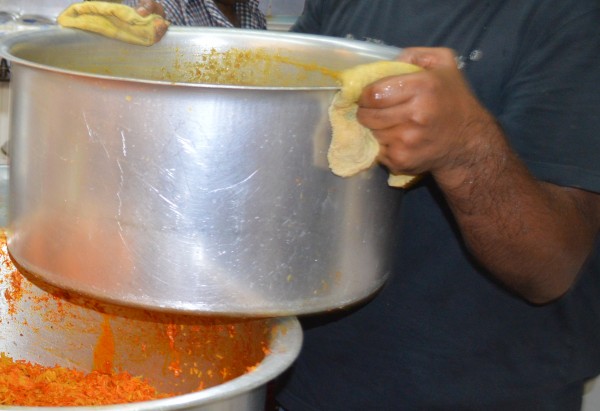Happy new year! At times like this, it is usual to make resolutions. A common New Year resolution is to live healthier than last year. Part of living healthier is eating healthier. Consumption of fruits, vegetables, seeds and beans are all essential parts of a well-balanced and healthy diet, but beware that your food id either edible or poisonous and detrimental to health.

While most of us don’t think about the way we consume everyday foods, there are reasons behind why we are trained to eat only certain parts of their anatomy. Even during food processing, there are several procedures that strip foods of their poisons to make them human-friendly.
People infected with food-borne organisms may be symptom-free or may have symptoms ranging from mild intestinal discomfort to severe dehydration and bloody diarrhoea. Depending on the type of infection, people can even die as a result of food poisoning.
More than 250 different diseases can cause food poisoning. Some of the most common diseases are infections caused by bacteria, such as Campylobacter,Salmonella, Shigella, E. coli O157:H7, Listeria, botulism and norovirus. Here are some foods to be wary of this year.
Clams
Avoid eating Red or Blood Clams, regardless if they’re a delicacy. Known to cause hepatitis A & E, typhoid and dysentery, these red clams have been banned in many countries, but could be encountered as sushi. You can be assured of its safety – as long as you have proof that they were safely cultivated! Illegal imports of clams are common in most Chinatown settlements, so be forewarned!
Elderberries
Elderberries, delightful as marmalade, wine and pancake syrup, have a dark secret hidden in its branches: cyanide. While it is a beautiful plant, don’t be fooled! This plant, often used in medicinal syrups, sodas and liquors can cause a severely upset stomach if consumed incorrectly. The flowers are the part of the plant used to make all things elderberry. The stems and various other parts of the plant, when consumed, can cause severe stomach issues. Take caution when drinking herbal teas made of elderberry leaves, and don’t even think about eating the unripe fruits and flowers that contain a toxic alkaloid.
Mushrooms
There are mushrooms called toadstools, some of which are known for being incredibly poisonous. Some poisonous mushrooms can kill; however, some choice edible species are brightly colored, while most poisonous species are brown or white. An important rule is not to consume mushrooms unless you are 100 per cent sure of what they are. Good rules that apply for avoiding poisonous mushrooms include avoiding mushrooms with white gills, a skirt or ring on the stem and a bulbous or sack like base and mushrooms with red on the cap or stem. Always stick to mushrooms you can buy at a supermarket. They should have a flat cap with no bumps, and the gills within the mushroom should either be grey or have a pink hue.
Castor Oil
Castor oil comes from the castor bean plant also called African Coffee Tree. Castor seeds are poisonous and lethal dose of castor seeds for adults is about four to eight seeds. Castor oil is produced by pressing ripe seeds that have had their outer covering (hull) removed. The hull contains a deadly poison called ricin, a water-soluble toxin. Ricin is extremely toxic. Castor oil does not contain ricin and is perfectly safe, but poisoning from eating the seed itself is rare but possible. One single castor bean can drop a human to his or her knees. Four can potentially kill a horse. Carefully handle and prepare castor oil. Castor beans undergo strict safety guidelines which must be met in order to be placed on shelves.
Almonds
Bitter almonds, when served raw, are full of cyanide. Although the almonds bought at the grocery store contain a small amount of cyanide, it’s not enough to poison you. However, eating too many bitter almonds, may not be so good for your health and may lead to cyanide poisoning. In order to remove the toxins, they must go through a specialized heat treatment. However the risk is great and even though a delectable treat is best avoided. Bitter almonds that have been processed and heated may however be safe for be consumed.
Cherries
Often enjoyed raw, in pies or in other popular treats, cherries are hazardous. Be wary and cautious of their seeds, which contain hydrogen cyanide. Your body can detoxify small quantities of cyanide compounds. If you accidentally eat a cherry pit in a pie or swallow an apple seed or two, you’ll be fine. Actually, if you swallow several seeds whole, you would absorb a minimal amount of the toxic compounds. However, ingesting just one or two freshly crushed pits can lead to death. Cherry seeds that are crushed, chewed or even slightly injured can be a potential threat. Don’t chew on the seeds.
Apples and pears
An apple a day will keep the doctor away. That is, unless you eat too many of the popular fruit’s seeds. Apples and pears both have seeds that contain compounds capable of turning into lethal cyanide when ingested. Luckily you’d have to really mash those seeds before the cyanide-making compounds can take effect. The seeds within one apple are not enough to become dangerous. Be aware of your apple consumption, and be sure to pluck the seeds as you go. Apples are a delicious and healthy snack when prepared properly.
Rhubarb
When we think rhubarb, pies and pudding come to mind. Underrated and easy to grow at home, this plant can be great. However, its leaves contain a double-threat: corrosive acid and oxalic acid, a chemical that’s also used in household bleach and anti-rust products. Eating the leaves can cause burning sensations in the mouth and throat, nausea, vomiting, convulsions, and even death. Even cooking the leaves won’t get rid of the acid. Avoid the leaves and look to the stalk. Make sure they are washed very carefully, and never use frost-bitten stalks.
Tomatoes
Known for their many beneficiary properties, such as Lycopene, tomatoes also contain the poison Glycoalkaloid in their leaves. Glycoalkaloid is known to cause upset stomach and cause severe cramping and nervousness. Avoid the leaves and stems of the tomato plant. They may be used to enhance flavour when preparing dishes, but must be removed before consuming.
Potatoes
Potatoes are another vegetable with poisonous stems and leaves. Depending on how they’re handled, potatoes can produce solanine, a natural pesticide that’s toxic to humans. The compound is particularly concentrated in potatoes that have started to turn green, and especially when they’ve begun to sprout. Vomiting, diarrhea, and sometimes cardiac arrest are usual suspects The good thing is that aside from looking kind of unappetizing and tasting slightly bitter, you’d have to eat an excessive amount of green potatoes to actually get solanine poisoning. Potato poisoning rarely occurs, but most fatalities have been attributed to eating green potatoes or drinking potato leaf tea. Avoid eating the stem or leaves.
Rice
Rice often contains arsenic, a toxin that can cause vomiting, abdominal pain, and vertigo when consumed in large quantities. The highest levels are found in brown rice, the lowest in instant rice. Despite the toxin’s presence, it would be incredibly difficult to poison yourself by eating too much rice in one day. That’s not to say nothing bad will happen; consistent exposure to even low doses of arsenic over time can lead to heart diseases and bladder cancer.
Source: Vanguard




